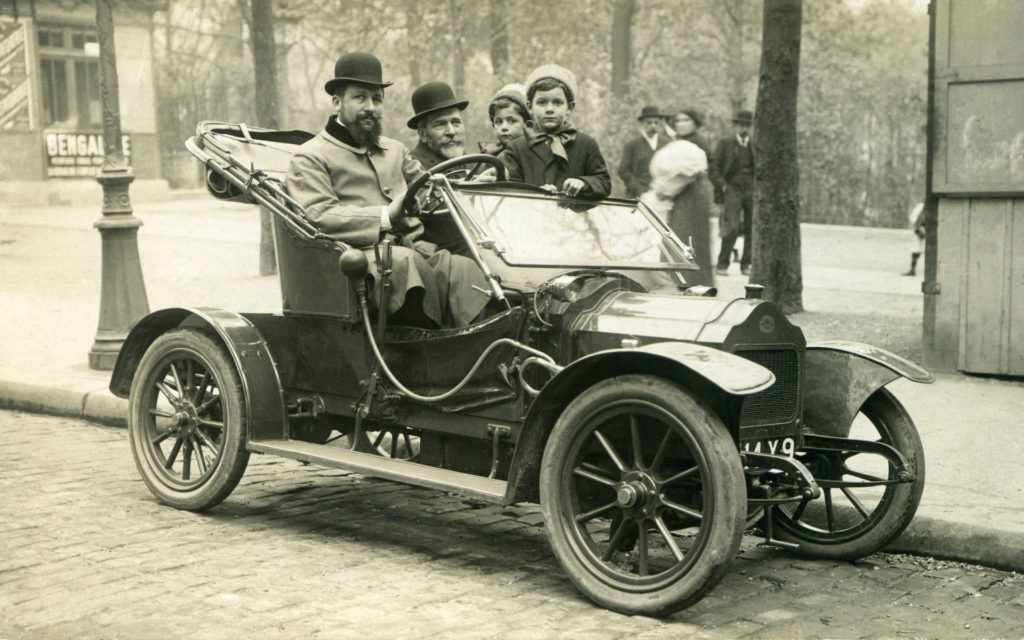Is Copyright Law a “Turnkey” Solution?
The ReDigi dispute has been going on since 2011. If you don’t believe me, you can read my blogs about it dating to then. I wrote an explainer last time about the Second Circuit’s recent decision against ReDigi’s marketplace for re-selling “used” digital files. But while the ReDigi case was pending, the Supreme Court issued a ruling that was somehow simultaneously unremarkable and astonishing: Aereo. And Aereo might have something so say about how ReDigi should have come out. I’ve blogged about the Aereo case plenty, just not nearly as much as ReDigi. If nothing else, it’s very difficult to read ReDigi and Aereo consistently with each other.

Is digital copyright law like this (digital is what digital does)…

…or like this (digital is how digital works)?
Aereo’s Secret Holding: Don’t Look Under the Hood?
In Aereo, the defendant hit upon a clever idea: capture free over-the-air television signals and stream them over the internet. If nothing else, it would let folks who, for whatever reason, can’t get a clear signal get the same level of free access as luckier folks had. Extended, it would permit folks who lived outside the television market get access to television stations.1For some reason, Aereo didn’t extend the service to those outside the television viewing area, which I think missed much of the point of the technology. The only problem with this idea was that, if you capture signals then send them to multiple customers, you are rebroadcasting the signal. Under the Copyright Act, rebroadcasting was a public performance of any works carried by the signal. You’re sending the signals to members of the public.
Aereo’s work-around was cute. Instead of one big antenna, Aereo deployed thousands of tiny antennae. Each tiny antenna had its own internet connection, and each internet connection was controlled by a single customer at a time. Further, the customer controlled whether the antenna was “turned on,” i.e., set to receive and transmit TV signals—and what station it was tuned to. The antenna was essentially an extension of the customer’s computer.
Since each antenna transmitted a signal to only a single customer, and the customer was the one controlling the antenna, the performance wasn’t public, since only one customer could access a given antenna at a time. Under a Second Circuit case called Cablevision, this was the correct result, and the Second Circuit had little choice but to hold that what Aereo was doing wasn’t copyright infringement.
Aereo went to the Supreme Court. Six justices were openly skeptical of what Aereo was doing. It certainly looked like a rebroadcast. It only stopped looking like a rebroadcast when you looked under the hood, at the nuts and bolts and how it all worked.
The Supreme Court was hellbent on reversing. There were a number of ways it could have done so. First, it could hold that Cablevision was wrong—it had that power—and thus Aereo was, too. Second, it could distinguish Cablevision—i.e., there was something fundamentally different between what Aereo was doing and what Cablevision was doing that meant they should be treated differently. Third, it could announce some newish principle of copyright law and leave it to lower courts and lawyers to pick up the pieces.
It did none of these things. It held that Aereo looked, sounded and smelled like a cable system, and since Copyright Act had special rules that assumed cable systems were rebroadcasting signals, Aereo must be infringing, too. Even people who wanted Aereo to go down were flabbergasted. Justice Scalia managed to pick his jaw up off the floor and write a typically blistering dissent that called out all the problems with the majority opinion: (1) it’s the statutory language, stupid; and (2) “infringement by resemblance.”
“Infringement by resemblance,” however, might be Aereo’s enduring legacy—if it has any. Aereo and Scalia wanted the Supreme Court to look at what Aereo actually did not what it behaved like. The Supreme Court chose to judge Aereo based on what it looked like it was doing, not in the technical details of how it did it. Perhaps this was a secret holding of Aereo: when considering copying infringement in the digital context, look at what it does, not how it works.
Mac-Avity: The Hidden Copy
There is much to recommend this approach. It’s a lot simpler. Instead of teasing apart the steps of the process, we just look at the process holistically. Thus, if it looks like you’re buying a book for your Kindle, then that’s what you’re doing: buying a book, just as though you went down to the local book shop and purchased a physical book. You could treat that “book” exactly as though you had purchased a physical book.
Until Aereo, courts didn’t look at digital content holistically, at all. If you purchased software for your computer, you didn’t “own” it. You just licensed it. Further, because the software can’t work unless it’s copied into memory, you need a license from the software publisher to even use it. This is a far cry from a book, which you can “use” over and over without anyone’s permission. While most consumer software is licensed forever, enterprise software often has limited terms that must be renewed and can be terminated if you don’t hold up your end of the bargain. The software publisher has an awful lot of leverage in that situation, as you can imagine.2This business model has been in decline for several years now, to be replaced by software as a service, which doesn’t rely so much on copyright enforcement. This applies to digital content, like that Kindle book, which also must be loaded into memory to be used. This is why sometimes books disappear from your Kindle when you cross international borders: the book was licensed for the country you were just in but not for the you just entered. With a regular book, of course, you don’t have that problem.
So, did the Supreme Court just tell us to stop looking under the technological hood? Well, not so fast. Where did this idea that using software violated the reproduction right even come from? After all, it’s a pretty strange concept. Software isn’t in computer memory for very long, and the copy is just a way-station between the thing you bought and your enjoyment of the thing you bought.
This issue came up in 1976, when Congress was considering enacting the Copyright Act of 1976.3Spoiler: Congress ended up enacting the Copyright Act of 1976 in 1976. Less obvious: it didn’t take effect until 1978. Software was fairly well-understood in those days, though it was not much of an industry. In those days, that intermediate copy was more obvious because you had to tell the computer to first “load” the program, i.e., copy it into memory, then run it. Congress, perhaps wisely, punted the issue by creating a committee to study the issue. The committee issued a report, which Congress mostly didn’t ignore, and Congress amended the Copyright Act in 1978 to explicitly include software programs as copyrightable subject matter.4Let’s give Congress a bit of credit here. Usually, when a committee is formed to study an issue, Congress gets to ignoring the committee’s recommendations right away. Here, Congress was sincere about wanting to understand software and how copyright law applied might apply to it. Different times, I guess. Congress further created an affirmative defense that gave the “owner of a copy of a computer program” the right to load software into memory in order to use it.5Unfortunately, no one’s quite sure what “owner of a copy of computer program” means. Does it include licensees? Does it include some licensees but not others? This issue will give you a headache. Worse, that committee I was talking about? It recommended having this affirmative defense explicitly available to anyone with a right to use a program, such as licensees.
It’s fairly clear, then, that Congress understood the intermediate copy of software to infringe the reproduction right. It’s, therefore, also fairly clear that Congress intended for copyright’s application to depend on how a digital device works, rather than what it resembles.
Zeno’s Aereo Revisited
As for enduring legacy of Aereo? I’m guessing there isn’t one. The Supreme Court just got the framework wrong6Which doesn’t necessarily mean the Supreme Court got the result wrong. There are ways to get to finding Aereo liable without “infringement by resemblance.”, and Aereo is a one-off. If Aereo‘s hidden holding were to prevail, it would be a major (but not necessarily unwelcome) change and disruption to almost every industry that touches digital content. Alas, Aereo is destined to be one of those Supreme Court decisions that happened—you could cite it—but no one will ever cite it successfully for anything significant.
As it happens, the Second Circuit made no citation to Aereo, even though it was a relevant Supreme Court decision. It’s possible ReDigi just didn’t make the argument (there are only so many page in an appellate brief and this isn’t an argument you can make half-heartedly). But perhaps that’s just as well: no one really wants to play with Aereo.
Here’s hoping this is the last time I ever blog about ReDigi! But if the case ends up before the Supreme Court, well, I’m here for that.
Thanks for reading!
Footnotes
| ↑1 | For some reason, Aereo didn’t extend the service to those outside the television viewing area, which I think missed much of the point of the technology. |
|---|---|
| ↑2 | This business model has been in decline for several years now, to be replaced by software as a service, which doesn’t rely so much on copyright enforcement. |
| ↑3 | Spoiler: Congress ended up enacting the Copyright Act of 1976 in 1976. Less obvious: it didn’t take effect until 1978. |
| ↑4 | Let’s give Congress a bit of credit here. Usually, when a committee is formed to study an issue, Congress gets to ignoring the committee’s recommendations right away. Here, Congress was sincere about wanting to understand software and how copyright law applied might apply to it. Different times, I guess. |
| ↑5 | Unfortunately, no one’s quite sure what “owner of a copy of computer program” means. Does it include licensees? Does it include some licensees but not others? This issue will give you a headache. Worse, that committee I was talking about? It recommended having this affirmative defense explicitly available to anyone with a right to use a program, such as licensees. |
| ↑6 | Which doesn’t necessarily mean the Supreme Court got the result wrong. There are ways to get to finding Aereo liable without “infringement by resemblance.” |

